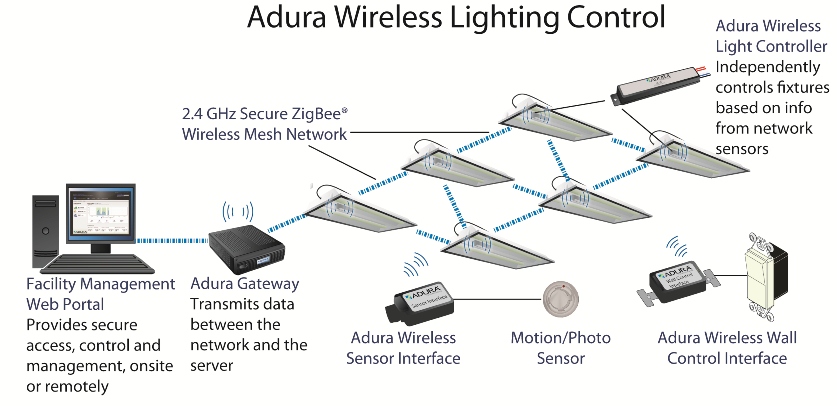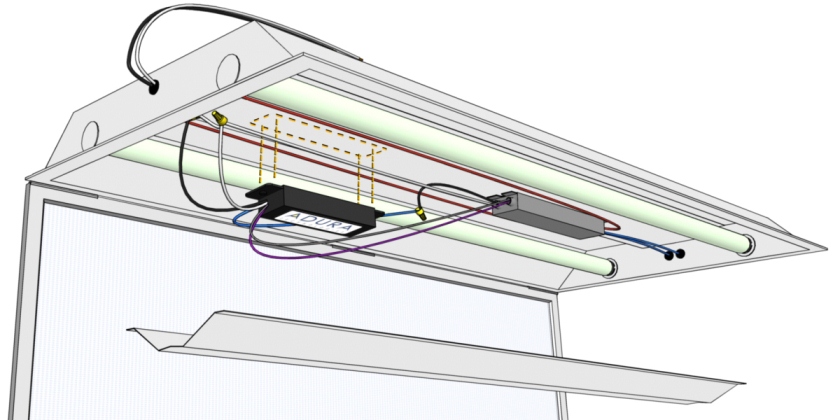
|
March 2012 |
[an error occurred while processing this directive] |
|
Networked Lighting Offers End-User Responsiveness To
save energy, meet energy code and life safety code requirements and
respond to occupants, lighting controls need to be networked together. |
| Articles |
| Interviews |
| Releases |
| New Products |
| Reviews |
| [an error occurred while processing this directive] |
| Editorial |
| Events |
| Sponsors |
| Site Search |
| Newsletters |
| [an error occurred while processing this directive] |
| Archives |
| Past Issues |
| Home |
| Editors |
| eDucation |
| [an error occurred while processing this directive] |
| Training |
| Links |
| Software |
| Subscribe |
| [an error occurred while processing this directive] |
The age of responsive lighting is here. To save energy, meet energy code and life safety code requirements and respond to occupants, lighting controls need to be networked together.
Office
lights aren’t just on or off anymore. There are many reasons to
dim office lights – daylight and other ambient light is too bright, an
area is temporarily unoccupied, demand response and even personal
preference. Future energy codes point toward a dimming future
because the energy savings potential is substantial.
For
each reason to dim, there’s a lighting control strategy
to help –
daylight harvesting, occupancy sensors, automated demand response and
task tuning to name a few. Each strategy adds incremental savings but
each by itself doesn’t necessarily justify the cost – especially if
using a wired lighting control system. In a wired system, the
complexity of the wiring required is prohibitive. It takes hours
of engineering to design zones. And what if the zones change
after design? A truly cost-effective system will layer multiple control
strategies to create responsive control. In addition, responding to
future changes in the office environment is critical without incurring
the cost of rewiring or extensive reprogramming. That’s why in a new
age of office lighting, a wireless lighting control system is
imperative.
One of the challenges for a new lighting system is matching historical expectations with new capabilities. For instance, wall switches are expected and required by energy codes. With an intelligent system, wall switches can respond appropriately based on the context. During the day, a wall switch can be used to raise or lower the light level. During unoccupied hours that same wall switch becomes an energy code compliant override switch.
Office
lighting is designed for the average person. Have you ever
met an “average” person? In our experience, not many occupants prefer
an average level. Many occupants prefer less light than average.
With the kind of granular control enabled by an intelligent wireless
lighting control system, each occupant can adjust their lights to their
preferences based on the amount of ambient light and their own comfort
level.
But, while lights in an open office should be responsive to an individual’s needs, there is an expectation of some uniformity. In interviews assessing client needs, lighting control companies have found there is clearly a threshold where the “popcorn” effect where lights pop on seemingly at random is distracting and possibly annoying. However, in office lighting there is some acceptable level of starting time diversity. For instance, it is not uncommon to mix programmed start and instant start ballasts in the same environment. Lighting expectations have been set by the difference in starting time by programmed start ballasts with a one second or more delay and instant start ballasts with almost no delay. In the early days of wireless lighting controls there was considerable concern about eliminating the “popcorn” effect. However, available wireless lighting systems are capable of controlling large office areas with a level of uniformity that is rarely noticed by an occupant.
Occupancy sensors are an established part of a modern office environment. They are a wonderful technology but are not without their frustrations. Connecting occupancy sensors to a networked system makes them better. Instead of turning lights off when an occupant is no longer sensed, the lights can dim to a transition scene before shutting off. If an occupant is still present, this transition scene is much less disturbing than being left in the dark. In addition, occupancy sensor performance can be monitored over the networked system. Collected data can be analyzed and used to optimize time delays. Time delays can adjust remotely over the network without disturbing the occupants. By remotely monitoring occupancy sensors, it is also possible to find sensors that have failed or that are being falsely tripped by an environmental condition such as the presence of a hot coffee pot.
A wireless system allows the use of multiple occupancy sensors to switch on a zone without running great lengths of wires. An intelligent networked system allows flexibility by context. In an open office the extent of control can change by the context. For instance, during the day, an occupancy sensor can control only its immediate area such as a cubicle or multiple cubicles. At night, an occupancy sensor can control additional lights to keep an egress path lit and to light up the perimeter of an office to make it feel safer.


Many in the lighting community are fans of reduced ambient light and improved task and under-cabinet lighting. Innovative and efficient LED lighting solutions are fueling this movement. Often these task and under-cabinet lights are successfully controlled by under desk occupancy sensors which turn the lights off when the cubicle is empty. However, there are few systems that bring the valuable information about cubicle occupancy to the control of ambient lights. Bridging this gap between the cubicle and hard installed building is physically challenging. Wireless control makes it possible for all office lighting to work as one unified system. Future codes are pointing toward controlling plug loads and task lighting based on occupancy. In the most intelligent systems, the devices in the cubicles and the ceiling mounted lighting will act together without requiring redundant sensors.
Daylight-responsive
dimming or daylight harvesting is another key
control strategy that reduces energy usage and promises to improve
occupant comfort in the working environment, yet it has many
challenges. The savings from daylight responsive dimming is not
enough to cost justify the cost of stand alone controls. However,
as an incremental addition to the savings in a multi-function lighting
control system it has huge benefits.
[an error occurred while processing this directive] One challenge of daylight responsive dimming is adjusting the response. Typical stand-alone controls are adjusted based on a one time observation on the day of startup. However, rarely is the technician armed with any tools to observe how his snapshot compares with the dynamic response throughout the year. Does the snapshot represent a typical condition or an outlier? With a standalone system, callbacks are typical. In a networked system, historical performance can be graphed and compared with occupants’ observations and adjustments can be made remotely.
Task tuning is another important control strategy. Some safety margin is typically built in to the selection of a lighting system. Once a lighting system is installed, it is often observed that there is more capacity than required and the light levels can be reduced. The spare capacity can be reserved for when needed; making the space more appealing as a work environment and saving energy. Task tuning is regaining prominence with the increased use of LEDs because now not only is spare capacity a concern but additionally lumen depreciation is a concern. LED fixtures have a much higher projected lumen depreciation than linear fluorescents. With proper task tuning, LEDs will not over light a space initially but rather will have a consistent light level throughout the life of the fixture. With task tuning, like so many other lighting control strategies, there must be a consideration of end user needs. The light level is bounded by expectations at the top and the bottom. The top or maximum light level is driven by the occupant expectation that they can have as much light as their neighbor. The bottom or minimum is driven by the expectation that an open office shall have a reasonable uniformity. Therefore, task tuning can only be successful when the lights are tuned with a holistic view, preferably using a lighting control system that provides the tools or intelligence to tune the lights in unison.
The challenges of lighting control will continue to increase. Future energy codes are looking at significantly reducing the number of uncontrolled “night” lights now common in most office buildings. These lights have been lit continuously to provide safe egress. However, they wasted energy. Turning these lights off when the area is empty will result in significant energy savings. However, the challenge is to meet this energy code requirement while also meeting the life safety code requirements for occupant egress. Life safety codes require that the entire path of egress be lit when an area is occupied. Stand alone control devices will be challenged to satisfy this requirement, in part because the optimal control strategy is different for times when an area is heavily occupied or when the area is sparsely occupied. Lighting control systems need to be responsive to the difference.
How can
all of these controls strategies work together? Lighting
control systems need to be intelligent, capable of prioritizing
different control strategies. Lighting control systems need to provide
the flexibility for different zones to respond to their individual
requirements, preferably through a highly distributed control system.
Lighting control systems need to be networked so that information can
be shared amongst devices as well as monitored remotely. Lighting
control systems need to be wireless so the amount of wiring is not
prohibitive.
About the Author
Doug
Paton is a Senior Product Manager at Adura Technologies, a wireless
lighting control company based in San Francisco. Doug joined
Adura in 2008. Doug has more than 25 years experience working
with lighting controls and building control systems. Doug has
spoken at LightFair, the lighting industry's premiere event, on the
topic of daylighting controls. He has a degree in Design of the
Environment from the University of Pennsylvania.
Doug can be reached at Doug@Aduratech.com
[an error occurred while processing this directive]
[Click Banner To Learn More]
[Home Page] [The Automator] [About] [Subscribe ] [Contact Us]